Krishnaram Kenthapadi
Permissioned LLMs: Enforcing Access Control in Large Language Models
May 28, 2025Abstract:In enterprise settings, organizational data is segregated, siloed and carefully protected by elaborate access control frameworks. These access control structures can completely break down if an LLM fine-tuned on the siloed data serves requests, for downstream tasks, from individuals with disparate access privileges. We propose Permissioned LLMs (PermLLM), a new class of LLMs that superimpose the organizational data access control structures on query responses they generate. We formalize abstractions underpinning the means to determine whether access control enforcement happens correctly over LLM query responses. Our formalism introduces the notion of a relevant response that can be used to prove whether a PermLLM mechanism has been implemented correctly. We also introduce a novel metric, called access advantage, to empirically evaluate the efficacy of a PermLLM mechanism. We introduce three novel PermLLM mechanisms that build on Parameter Efficient Fine-Tuning to achieve the desired access control. We furthermore present two instantiations of access advantage--(i) Domain Distinguishability Index (DDI) based on Membership Inference Attacks, and (ii) Utility Gap Index (UGI) based on LLM utility evaluation. We demonstrate the efficacy of our PermLLM mechanisms through extensive experiments on four public datasets (GPQA, RCV1, SimpleQA, and WMDP), in addition to evaluating the validity of DDI and UGI metrics themselves for quantifying access control in LLMs.
RedactOR: An LLM-Powered Framework for Automatic Clinical Data De-Identification
May 23, 2025Abstract:Ensuring clinical data privacy while preserving utility is critical for AI-driven healthcare and data analytics. Existing de-identification (De-ID) methods, including rule-based techniques, deep learning models, and large language models (LLMs), often suffer from recall errors, limited generalization, and inefficiencies, limiting their real-world applicability. We propose a fully automated, multi-modal framework, RedactOR for de-identifying structured and unstructured electronic health records, including clinical audio records. Our framework employs cost-efficient De-ID strategies, including intelligent routing, hybrid rule and LLM based approaches, and a two-step audio redaction approach. We present a retrieval-based entity relexicalization approach to ensure consistent substitutions of protected entities, thereby enhancing data coherence for downstream applications. We discuss key design desiderata, de-identification and relexicalization methodology, and modular architecture of RedactX and its integration with the Oracle Health Clinical AI system. Evaluated on the i2b2 2014 De-ID dataset using standard metrics with strict recall, our approach achieves competitive performance while optimizing token usage to reduce LLM costs. Finally, we discuss key lessons and insights from deployment in real-world AI- driven healthcare data pipelines.
Towards Trustworthy Retrieval Augmented Generation for Large Language Models: A Survey
Feb 08, 2025Abstract:Retrieval-Augmented Generation (RAG) is an advanced technique designed to address the challenges of Artificial Intelligence-Generated Content (AIGC). By integrating context retrieval into content generation, RAG provides reliable and up-to-date external knowledge, reduces hallucinations, and ensures relevant context across a wide range of tasks. However, despite RAG's success and potential, recent studies have shown that the RAG paradigm also introduces new risks, including robustness issues, privacy concerns, adversarial attacks, and accountability issues. Addressing these risks is critical for future applications of RAG systems, as they directly impact their trustworthiness. Although various methods have been developed to improve the trustworthiness of RAG methods, there is a lack of a unified perspective and framework for research in this topic. Thus, in this paper, we aim to address this gap by providing a comprehensive roadmap for developing trustworthy RAG systems. We place our discussion around five key perspectives: reliability, privacy, safety, fairness, explainability, and accountability. For each perspective, we present a general framework and taxonomy, offering a structured approach to understanding the current challenges, evaluating existing solutions, and identifying promising future research directions. To encourage broader adoption and innovation, we also highlight the downstream applications where trustworthy RAG systems have a significant impact.
Measuring Distributional Shifts in Text: The Advantage of Language Model-Based Embeddings
Dec 04, 2023



Abstract:An essential part of monitoring machine learning models in production is measuring input and output data drift. In this paper, we present a system for measuring distributional shifts in natural language data and highlight and investigate the potential advantage of using large language models (LLMs) for this problem. Recent advancements in LLMs and their successful adoption in different domains indicate their effectiveness in capturing semantic relationships for solving various natural language processing problems. The power of LLMs comes largely from the encodings (embeddings) generated in the hidden layers of the corresponding neural network. First we propose a clustering-based algorithm for measuring distributional shifts in text data by exploiting such embeddings. Then we study the effectiveness of our approach when applied to text embeddings generated by both LLMs and classical embedding algorithms. Our experiments show that general-purpose LLM-based embeddings provide a high sensitivity to data drift compared to other embedding methods. We propose drift sensitivity as an important evaluation metric to consider when comparing language models. Finally, we present insights and lessons learned from deploying our framework as part of the Fiddler ML Monitoring platform over a period of 18 months.
Designing Closed-Loop Models for Task Allocation
May 31, 2023Abstract:Automatically assigning tasks to people is challenging because human performance can vary across tasks for many reasons. This challenge is further compounded in real-life settings in which no oracle exists to assess the quality of human decisions and task assignments made. Instead, we find ourselves in a "closed" decision-making loop in which the same fallible human decisions we rely on in practice must also be used to guide task allocation. How can imperfect and potentially biased human decisions train an accurate allocation model? Our key insight is to exploit weak prior information on human-task similarity to bootstrap model training. We show that the use of such a weak prior can improve task allocation accuracy, even when human decision-makers are fallible and biased. We present both theoretical analysis and empirical evaluation over synthetic data and a social media toxicity detection task. Results demonstrate the efficacy of our approach.
Towards the Use of Saliency Maps for Explaining Low-Quality Electrocardiograms to End Users
Jul 06, 2022


Abstract:When using medical images for diagnosis, either by clinicians or artificial intelligence (AI) systems, it is important that the images are of high quality. When an image is of low quality, the medical exam that produced the image often needs to be redone. In telemedicine, a common problem is that the quality issue is only flagged once the patient has left the clinic, meaning they must return in order to have the exam redone. This can be especially difficult for people living in remote regions, who make up a substantial portion of the patients at Portal Telemedicina, a digital healthcare organization based in Brazil. In this paper, we report on ongoing work regarding (i) the development of an AI system for flagging and explaining low-quality medical images in real-time, (ii) an interview study to understand the explanation needs of stakeholders using the AI system at OurCompany, and, (iii) a longitudinal user study design to examine the effect of including explanations on the workflow of the technicians in our clinics. To the best of our knowledge, this would be the first longitudinal study on evaluating the effects of XAI methods on end-users -- stakeholders that use AI systems but do not have AI-specific expertise. We welcome feedback and suggestions on our experimental setup.
Visual Auditor: Interactive Visualization for Detection and Summarization of Model Biases
Jun 25, 2022

Abstract:As machine learning (ML) systems become increasingly widespread, it is necessary to audit these systems for biases prior to their deployment. Recent research has developed algorithms for effectively identifying intersectional bias in the form of interpretable, underperforming subsets (or slices) of the data. However, these solutions and their insights are limited without a tool for visually understanding and interacting with the results of these algorithms. We propose Visual Auditor, an interactive visualization tool for auditing and summarizing model biases. Visual Auditor assists model validation by providing an interpretable overview of intersectional bias (bias that is present when examining populations defined by multiple features), details about relationships between problematic data slices, and a comparison between underperforming and overperforming data slices in a model. Our open-source tool runs directly in both computational notebooks and web browsers, making model auditing accessible and easily integrated into current ML development workflows. An observational user study in collaboration with domain experts at Fiddler AI highlights that our tool can help ML practitioners identify and understand model biases.
A Human-Centric Take on Model Monitoring
Jun 06, 2022
Abstract:Predictive models are increasingly used to make various consequential decisions in high-stakes domains such as healthcare, finance, and policy. It becomes critical to ensure that these models make accurate predictions, are robust to shifts in the data, do not rely on spurious features, and do not unduly discriminate against minority groups. To this end, several approaches spanning various areas such as explainability, fairness, and robustness have been proposed in recent literature. Such approaches need to be human-centered as they cater to the understanding of the models to their users. However, there is a research gap in understanding the human-centric needs and challenges of monitoring machine learning (ML) models once they are deployed. To fill this gap, we conducted an interview study with 13 practitioners who have experience at the intersection of deploying ML models and engaging with customers spanning domains such as financial services, healthcare, hiring, online retail, computational advertising, and conversational assistants. We identified various human-centric challenges and requirements for model monitoring in real-world applications. Specifically, we found the need and the challenge for the model monitoring systems to clarify the impact of the monitoring observations on outcomes. Further, such insights must be actionable, robust, customizable for domain-specific use cases, and cognitively considerate to avoid information overload.
Are Two Heads the Same as One? Identifying Disparate Treatment in Fair Neural Networks
Apr 09, 2022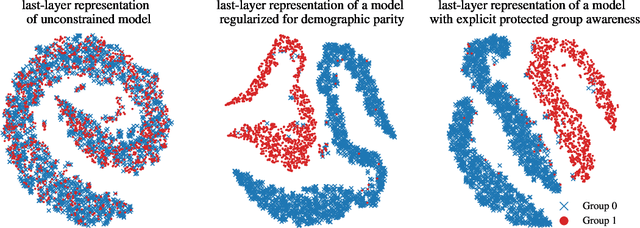
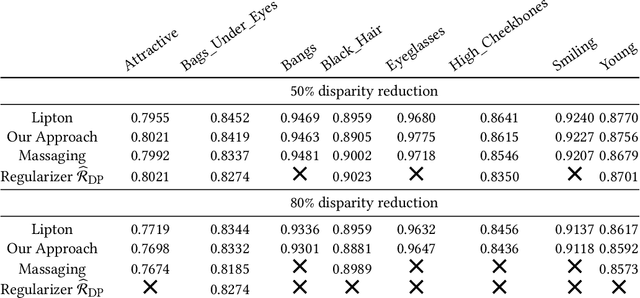

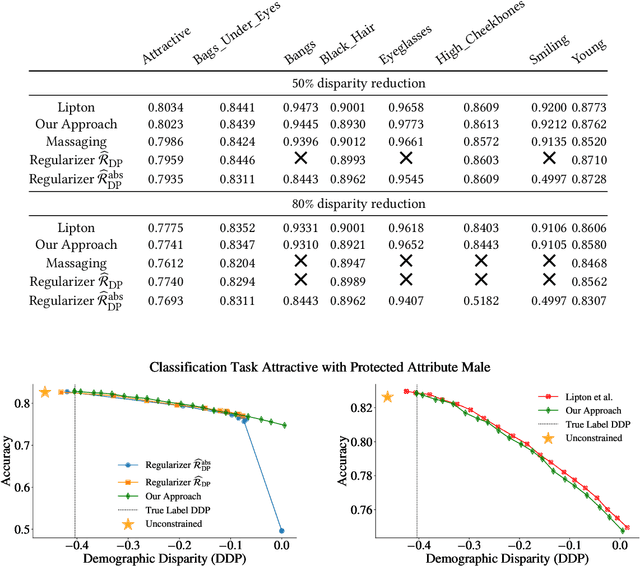
Abstract:We show that deep neural networks that satisfy demographic parity do so through a form of race or gender awareness, and that the more we force a network to be fair, the more accurately we can recover race or gender from the internal state of the network. Based on this observation, we propose a simple two-stage solution for enforcing fairness. First, we train a two-headed network to predict the protected attribute (such as race or gender) alongside the original task, and second, we enforce demographic parity by taking a weighted sum of the heads. In the end, this approach creates a single-headed network with the same backbone architecture as the original network. Our approach has near identical performance compared to existing regularization-based or preprocessing methods, but has greater stability and higher accuracy where near exact demographic parity is required. To cement the relationship between these two approaches, we show that an unfair and optimally accurate classifier can be recovered by taking a weighted sum of a fair classifier and a classifier predicting the protected attribute. We use this to argue that both the fairness approaches and our explicit formulation demonstrate disparate treatment and that, consequentially, they are likely to be unlawful in a wide range of scenarios under the US law.
Diverse Counterfactual Explanations for Anomaly Detection in Time Series
Mar 21, 2022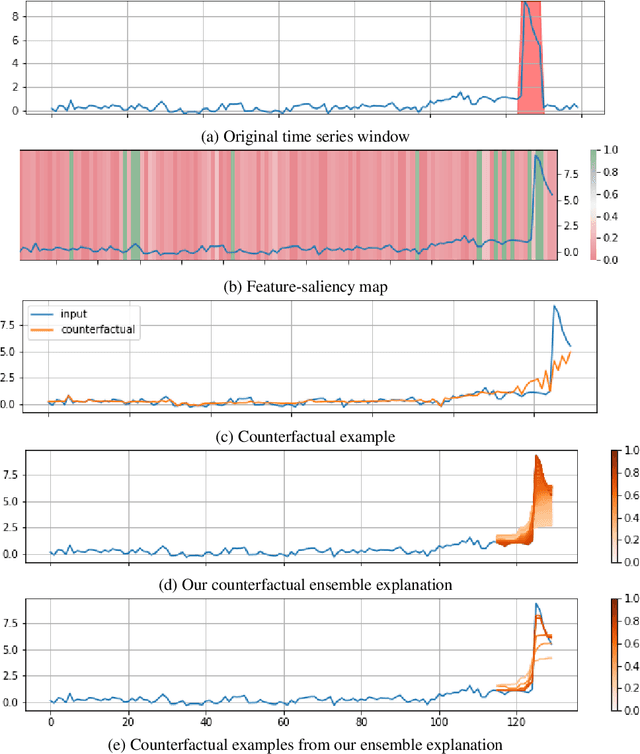


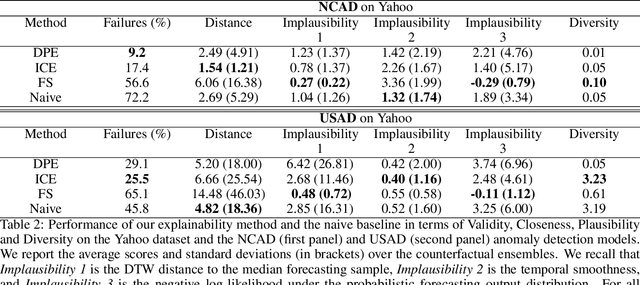
Abstract:Data-driven methods that detect anomalies in times series data are ubiquitous in practice, but they are in general unable to provide helpful explanations for the predictions they make. In this work we propose a model-agnostic algorithm that generates counterfactual ensemble explanations for time series anomaly detection models. Our method generates a set of diverse counterfactual examples, i.e, multiple perturbed versions of the original time series that are not considered anomalous by the detection model. Since the magnitude of the perturbations is limited, these counterfactuals represent an ensemble of inputs similar to the original time series that the model would deem normal. Our algorithm is applicable to any differentiable anomaly detection model. We investigate the value of our method on univariate and multivariate real-world datasets and two deep-learning-based anomaly detection models, under several explainability criteria previously proposed in other data domains such as Validity, Plausibility, Closeness and Diversity. We show that our algorithm can produce ensembles of counterfactual examples that satisfy these criteria and thanks to a novel type of visualisation, can convey a richer interpretation of a model's internal mechanism than existing methods. Moreover, we design a sparse variant of our method to improve the interpretability of counterfactual explanations for high-dimensional time series anomalies. In this setting, our explanation is localised on only a few dimensions and can therefore be communicated more efficiently to the model's user.
 Add to Chrome
Add to Chrome Add to Firefox
Add to Firefox Add to Edge
Add to Edge